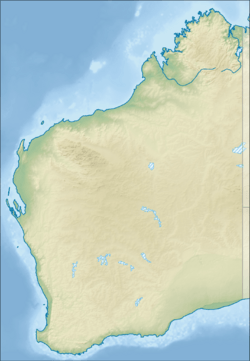Lake Chinocup facts for kids
Quick facts for kids Lake Chinocup |
|
|---|---|
| Location | Great Southern, Western Australia |
| Coordinates | 33°29′56″S 118°24′59″E / 33.49889°S 118.41639°E |
| Type | Saline |
| Primary inflows | Groundwater and surface runoff |
| Catchment area | 3,500 km2 (1,400 sq mi) |
| Basin countries | Australia |
| Surface area | 12,000 ha (30,000 acres) |
| Surface elevation | 280 m (920 ft) |
Lake Chinocup, also called Chinocup Lake, is a salt lake in Western Australia. It is found in the Great Southern area. The lake is located between the towns of Nyabing and Pingrup. It is about 1 kilometer (0.6 miles) north of the small town of Chinocup.
The town of Chinocup got its name from the lake. The name "Chinocup" comes from an Aboriginal word. Its exact meaning is not known today. The lake was officially named in the year 1879.
Contents
Discover Lake Chinocup
Lake Chinocup is a special kind of lake called a salt lake. This means its water is salty, much like the ocean. It is not fresh water that you can drink.
The lake is part of a bigger group of lakes. This group is known as the Chinocup Lake system. These lakes stretch from north to south. They run between Pingrup and Lake Grace. Scientists believe these lakes are part of a very old river system.
Why Some Lakes Are Pink
Some of the lakes in this system have a unique color. They can appear pink! This happens because of tiny living things in the water. These tiny organisms are a type of bacteria called Halobacterium. They thrive in salty environments.
Size and Location
Lake Chinocup covers a large area. It is about 12,000 hectares (29,653 acres) in size. To give you an idea, that's like 12,000 football fields!
The lake is part of a protected area. This area is called the Lake Chinocup Reserve. The reserve itself is even bigger. It has a total area of 19,825 hectares (49,000 acres).
Water Sources and Connections
The land that collects water for the lake is called its catchment area. Lake Chinocup's catchment area is very big. It covers about 3,500 square kilometers (1,351 square miles). This area includes the Lake Chinocup Reserve. It also includes the Lake Magenta Reserve, which is about 94,000 hectares (232,278 acres). Plus, it includes farmland nearby.
The lake system is connected to other rivers. It is part of the Lockhart River catchment. This Lockhart River system is part of an even larger area. It belongs to the huge Avon River basin. The Pingrup River actually starts from Lake Chinocup. It then flows as part of the Lockhart system.
Plants Around the Lake
The area around Lake Chinocup has many different plants. Right next to the lake, you will find plants called samphire. These plants can grow well in salty soil.
Further from the lake, there are areas of Melaleuca scrub. There is also a small patch of Casuarina obesa trees.
Woodlands and Rare Plants
On higher ground, away from the lake, you can find woodlands. These are called mallee scrub woodlands. The main trees in these woodlands are Eucalyptus incrassata, Eucalyptus kondininensis, and Eucalyptus phaenophylla.
Underneath these taller trees, you might see other plants. One example is Adenanthos pungens. The reserve is also home to some very special plants. There are two types of plants that are rare. Six other types are considered "priority species." This means they are important to protect.
Mining Near the Lake
In 1994, there was a plan to mine for gypsum near the lake. Gypsum is a soft mineral. It is used to make plasterboard and fertilizer.
The proposed mining area was about 70 hectares (173 acres) in size. The company doing the mining would have to pay a large amount of money. This money would be a promise. It would make sure they fix the land after they finish mining. This process is called rehabilitation.


